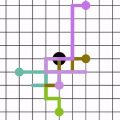Computing stands to be radically improved by neuromorphic computing (NMC) approaches inspired by the brain's incredible efficiency and capabilities. Most NMC research, which aims to replicate the brain's computational structure and architecture in man-made hardware, has focused on artificial intelligence; however, less explored is whether this brain-inspired hardware can provide value beyond cognitive tasks. We demonstrate that high-degree parallelism and configurability of spiking neuromorphic architectures makes them well-suited to implement random walks via discrete time Markov chains. Such random walks are useful in Monte Carlo methods, which represent a fundamental computational tool for solving a wide range of numerical computing tasks. Additionally, we show how the mathematical basis for a probabilistic solution involving a class of stochastic differential equations can leverage those simulations to provide solutions for a range of broadly applicable computational tasks. Despite being in an early development stage, we find that NMC platforms, at a sufficient scale, can drastically reduce the energy demands of high-performance computing (HPC) platforms.
翻译:由大脑令人难以置信的效率和能力所启发的神经形态计算(NMC)方法可以极大地改进计算。 大部分NMC研究旨在复制大脑的计算结构和结构,其重点是人工硬件;然而,探索较少的是,这种由大脑启发的硬件能否提供超越认知任务的价值。 我们证明,神经形态结构的高度平行性和可配置性使得它们非常适合通过离散时间Markov链进行随机行走。这种随机行走在蒙特卡洛方法中是有用的,它代表了解决多种数字计算任务的基本计算工具。此外,我们展示了涉及某类随机差异方程式的概率解决方案的数学基础如何利用这些模拟为一系列广泛适用的计算任务提供解决方案。尽管处于早期开发阶段,但我们发现NMC平台在足够大的规模上可以大幅降低高性计算平台的能量需求。


